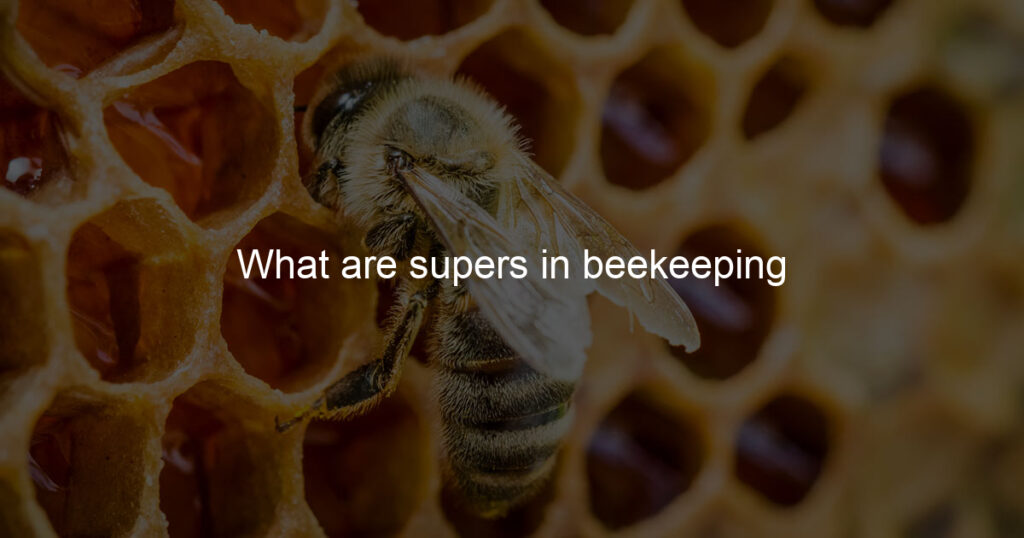If you’ve ever been interested in beekeeping, you have no doubt heard the term “supers”. It’s a key component in modern beekeeping and it can be overwhelming for beginners to understand what it is all about.
In this blog post, we will look at the basics of supers – from what they are and how they work, to why they are so important and the different types of supers available today. We’ll also share tips on how best to use them to ensure maximum productivity from your hive while keeping your bees healthy and happy!
How many supers should a hive have?
When it comes to supers, it’s important to consider how much honey your hive is likely to produce before deciding on the number you should keep. Too many and the bees won’t have enough workforce to store their surplus honey. Too little and they run out of space and escape from the hive in search of food elsewhere.
The rule of thumb here is that one super can typically store around 30-45 pounds of honey per season, so add additional supers as needed depending on the size of your hive and the amount of nectar it’s gathering.
In general, most beehives will tend towards four or five supers, but others may need more or less depending on individual circumstances. Whatever you decide, make sure to ensure your hives are adequately supplied with protective gear like anti-mite treatments too!
What is the difference between a hive body and a super?
In beekeeping, a hive body is an integral part of the whole habitat, which houses the comb and bees. Typically, these are 8-frame or 10-frame boxes that are stacked one on top of the other and made from either wood or plastic. A super, on the other hand, is an additional box that sits on top of the hive body to give extra room for honey storage and brood production.
While supers can be used for cluster reversal during the swarming season or for varroa mite control, they are mainly designed to store excess honey/pollen when the nectar flow is heavy. Therefore, although both components form part of a beehive, they each serve different roles – while hives bodies provide space for raising bees and storing honey/pollen in general; supers offer additional space specifically purposed to store excess honey during periods of plentiful nectar flow.
How quickly can bees fill a super?
Bees have amazed people for centuries with the astounding speed and efficiency of their work, and this is perhaps no more evident than when observing them in the act of filling a super.
It only takes bees a matter of hours to get a full honeycomb created, uncapping any new cells they find along the way. This usually happens during the warmer times of the year when there is plenty of nectar in the air, providing them with ample opportunity to work their magic. It’s truly breathtaking just how much these industrious little creatures can achieve in such a small amount of time.
Will add a super prevent swarming?
The addition of a new “super” beehive can help prevent swarming, especially when the hives are managed properly. Swarming is a natural process in which honey bees split into two groups and separate to create a new colony.
While it’s part of the bee life cycle, it can have an unwanted effect on honey production and reduce hive populations. These hives are built to prevent overcrowding and if checked periodically to ensure that food stores are adequate, this helps break the trigger for swarming.
Furthermore, care needs to be taken so that queen cells are not formed, as this is another signal indicating that swarming could occur. By following these management techniques and adding supers when needed, beekeepers can help reduce their colonies from leaving in search of pastures new.
Looking Ahead: What are supers in beekeeping?
Our understanding of bees and beekeeping has grown over time, along with the roles of different beekeepers within a colony. By learning about supers and their purpose in the hive, the hidden complexity of the bee world is suddenly made much clearer.
It emphasizes how important bees are for sustaining our environment by aiding in pollination, meaning any disruption caused to a local bee population can have serious implications on global ecology. Above all, it shows that when we work together as a community, everyone from the amateur hobbyist to experienced professionals can gain valuable insights into the complex role that supers can play in managing hives.
In doing so, we take one more step towards connecting with this powerful symbol of insect engineering and its positive effects on the world around us.








